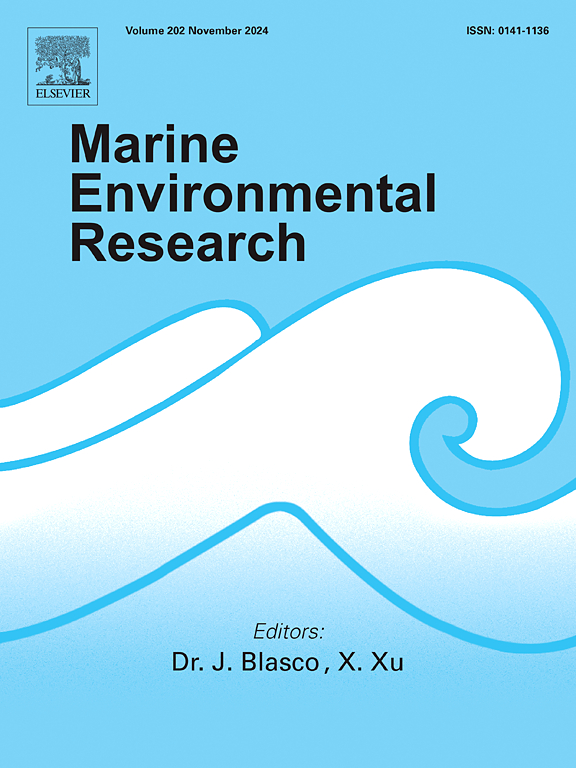Exploring the over-wintering and over-summering mechanisms of Ulva prolifera from physiological and transcriptome perspectives and their impacts on green tides
IF 3.2
3区 环境科学与生态学
Q2 ENVIRONMENTAL SCIENCES
引用次数: 0
Abstract
Since 2007, the South Yellow Sea region of China has endured the world's largest recurrent green tide disaster for 18 consecutive years, resulting in substantial economic losses and ecological risks. Ulva prolifera the dominant species in these green tides, demonstrates remarkable tolerance to both elevated and reduced temperatures, with its thermal adaptation mechanisms critically linked to seasonal outbreak dynamics. This study established three temperature regimes (5 °C, 20 °C, and 30 °C) based on recent extreme temperature records from the Yellow Sea region to systematically evaluate growth rates, photosynthetic performance, pigment profiles, antioxidant enzyme activities, and transcriptomic responses of U. prolifera. Results revealed optimal growth at 15–25 °C, with significant growth inhibition beyond this range. Elevated temperature (30 °C) induced modest increases in photosynthetic fluorescence parameters and pigment content, coupled with pronounced enhancement of peroxidase (POD) activity. Conversely, low-temperature exposure (5 °C) substantially suppressed both photosynthetic efficiency and pigment levels, while eliciting only marginal POD activation. Transcriptomic profiling demonstrated distinct survival strategies: Low temperatures triggered the activation of the protein synthesis pathway and basal metabolic maintenance to prolong viability, whereas high temperatures activated antioxidant defenses and metabolic reprogramming to sustain photosynthetic function and nutrient cycling. Machine learning analysis revealed that proteins related to protein modification and cell differentiation exhibited strong responses under temperature stress. These temperature-responsive regulatory networks underpin the seasonal proliferation patterns of U. prolifera green tides. The findings advance mechanistic understanding of its overwintering and summer endurance strategies, offering critical theoretical frameworks for ecological management and mitigation technologies.
从生理和转录组学角度探讨增生Ulva的越冬和越夏机制及其对绿潮的影响
自2007年以来,中国南黄海地区连续18年遭受世界上最大的周期性绿潮灾害,造成了巨大的经济损失和生态风险。这些绿潮中的优势物种增生Ulva (Ulva prolifera)对升高和降低的温度都表现出显著的耐受性,其热适应机制与季节性疫情动态密切相关。本研究基于黄海地区最近的极端温度记录,建立了3个温度区(5°C、20°C和30°C),系统地评估了U. prolifera的生长速率、光合性能、色素谱、抗氧化酶活性和转录组反应。结果表明,在15-25°C的温度下生长最佳,超过这个温度范围,生长受到明显抑制。高温(30°C)诱导光合荧光参数和色素含量适度增加,同时过氧化物酶(POD)活性显著增强。相反,低温暴露(5°C)大大抑制了光合效率和色素水平,而只引起边际POD激活。转录组学分析显示了不同的生存策略:低温触发了蛋白质合成途径的激活和基础代谢维持,以延长生存能力,而高温激活了抗氧化防御和代谢重编程,以维持光合功能和营养循环。机器学习分析显示,与蛋白质修饰和细胞分化相关的蛋白质在温度胁迫下表现出强烈的反应。这些温度响应调节网络支撑着藻绿潮的季节性增殖模式。这些发现促进了对其越冬和夏季耐力策略的机制理解,为生态管理和缓解技术提供了关键的理论框架。
本文章由计算机程序翻译,如有差异,请以英文原文为准。
求助全文
约1分钟内获得全文
求助全文
来源期刊

Marine environmental research
环境科学-毒理学
CiteScore
5.90
自引率
3.00%
发文量
217
审稿时长
46 days
期刊介绍:
Marine Environmental Research publishes original research papers on chemical, physical, and biological interactions in the oceans and coastal waters. The journal serves as a forum for new information on biology, chemistry, and toxicology and syntheses that advance understanding of marine environmental processes.
Submission of multidisciplinary studies is encouraged. Studies that utilize experimental approaches to clarify the roles of anthropogenic and natural causes of changes in marine ecosystems are especially welcome, as are those studies that represent new developments of a theoretical or conceptual aspect of marine science. All papers published in this journal are reviewed by qualified peers prior to acceptance and publication. Examples of topics considered to be appropriate for the journal include, but are not limited to, the following:
– The extent, persistence, and consequences of change and the recovery from such change in natural marine systems
– The biochemical, physiological, and ecological consequences of contaminants to marine organisms and ecosystems
– The biogeochemistry of naturally occurring and anthropogenic substances
– Models that describe and predict the above processes
– Monitoring studies, to the extent that their results provide new information on functional processes
– Methodological papers describing improved quantitative techniques for the marine sciences.
 求助内容:
求助内容: 应助结果提醒方式:
应助结果提醒方式:


